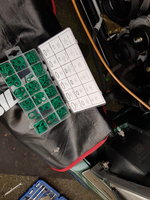Hi All,
I have several old benzes ranging from W124, W140, W211, W220 & W204 models. Most of which are low on Freon and require an AC service. A local garage used to do that for me but it would be VERY costly to ask them to take on half a dozen cars at once
Thus I want to carry out my own AC drain, vacuum testing, oil filling and Freon filling at home. Not using the little cheapie cans with gauges on them. Ideally by buying a good used AC service machine. I'll keep a lookout.
Do any of you guys use a vacuum pump at home to empty the system? (Technically into the atmosphere I guess ) What "Bulk" gas can you buy cost effectively and do you use the pair of gauges to hook up and test / monitor the system?
) What "Bulk" gas can you buy cost effectively and do you use the pair of gauges to hook up and test / monitor the system?
I will of course start researching this now and watching You Tube videos etc. But any pointers would be appreciated.
And yes I am in Ireland - and we require AC at least 3 days a year
I have several old benzes ranging from W124, W140, W211, W220 & W204 models. Most of which are low on Freon and require an AC service. A local garage used to do that for me but it would be VERY costly to ask them to take on half a dozen cars at once
Thus I want to carry out my own AC drain, vacuum testing, oil filling and Freon filling at home. Not using the little cheapie cans with gauges on them. Ideally by buying a good used AC service machine. I'll keep a lookout.
Do any of you guys use a vacuum pump at home to empty the system? (Technically into the atmosphere I guess
I will of course start researching this now and watching You Tube videos etc. But any pointers would be appreciated.
And yes I am in Ireland - and we require AC at least 3 days a year











 Id have to verify the compressor IS leaking though before committing further £££ into the AC system which has been neglected for at least a decade.
Id have to verify the compressor IS leaking though before committing further £££ into the AC system which has been neglected for at least a decade.



 This coupe would have cost nearly the same as a house back in the day so I will put whatever comparatively small £££ back into it to leave it right
This coupe would have cost nearly the same as a house back in the day so I will put whatever comparatively small £££ back into it to leave it right 